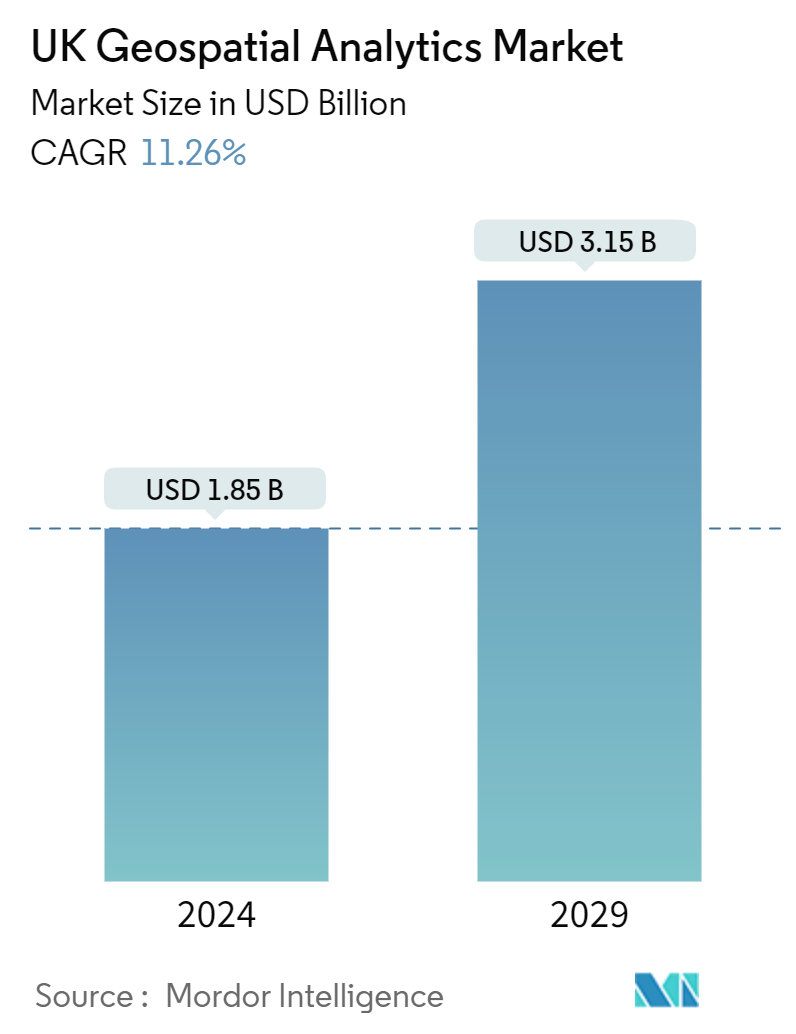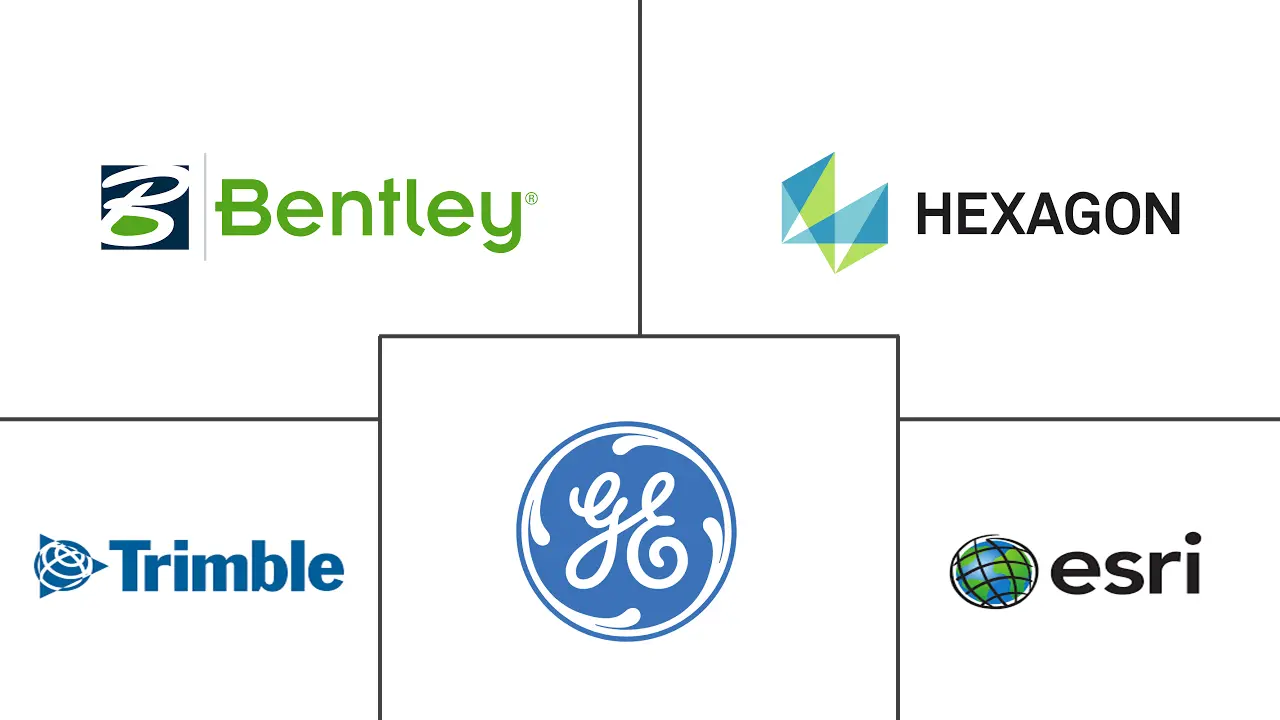Market Size of UK Geospatial Analytics Industry

| Study Period | 2019 - 2029 |
| Base Year For Estimation | 2023 |
| Market Size (2024) | USD 1.85 Billion |
| Market Size (2029) | USD 3.15 Billion |
| CAGR (2024 - 2029) | 11.26 % |
| Market Concentration | Medium |
Major Players
*Disclaimer: Major Players sorted in no particular order |
UK Geospatial Analytics Market Analysis
The UK Geospatial Analytics Market size is estimated at USD 1.85 billion in 2024, and is expected to reach USD 3.15 billion by 2029, growing at a CAGR of 11.26% during the forecast period (2024-2029).
Geospatial analytics is acquiring, manipulating, and displaying imagery and data from the geographic information system (GIS), such as satellite photos and GPS data. The specific identifiers of a street address and a zip code are used in geospatial data analytics. They are used to create geographic models and data visualizations for more accurate trends modeling and forecasting.
- Artificial intelligence (AI) and machine learning (ML) have increased organizations' ability to analyze massive amounts of geographical data. AI and several of its subdomains, such as machine learning and computer vision, automate information extraction to give real-time geographic insights more quickly, such as assisting in the safe deployment of firefighters during rescue operations or enabling autonomous or remote navigation for drones or vehicles.
- Geospatial analytics could be helpful in the building industry. Using Geographic Information Systems (GIS) tools, builders and developers can make informed decisions based on data-driven insights about location, zoning, and accessible resources.
- GIS technology may assist with anything from site selection to project management in the home development industry. GIS, for example, can be used to assess the appropriateness of a potential construction site's terrain for development. Furthermore, GIS can help builders discover potential environmental hazards that must be considered during construction.
- Rapid technology advancements have resulted in sat navs in automobiles, maps on phones, wearable sensors around our wrists, and smart devices in houses, all of which are now essential components of millions of people's lives.
- New and improved technologies are always being created. Drones will be used to map fields in the near future, as will robots on the street doing home deliveries - all of which will use geospatial data.
- The most significant impediment to the geospatial industry is a need for more understanding of the technology's robustness. This is the most significant impediment to individuals fully utilizing the technology. People are less likely to use technology if unaware of its considerable uses. Conversely, technology vendors see a need for more human resources as the most significant impediment to providing or developing an effective solution. Geospatial technology deployment necessitates specific skills, knowledge, and comprehension.
UK Geospatial Analytics Industry Segmentation
Geospatial analytics is acquiring, manipulating, and displaying imagery and data from the geographic information system (GIS), such as satellite photos and GPS data. The specific identifiers of a street address and a zip code are used in geospatial data analytics. They are used to create geographic models and data visualizations for more accurate trends modeling and forecasting.
The UK geospatial analytics market is segmented by type (surface analysis, network analysis, geovisualization), by end user vertical (agriculture, utility and communication, defence and intelligence, government, mining and natural resources, automotive and transportation, healthcare, real estate, and construction). The market sizes and forecasts are provided in terms of value (USD) for all the above segments.
| By Type | |
| Surface Analysis | |
| Network Analysis | |
| Geovisualization |
| By End-user Vertical | |
| Agriculture | |
| Utility and Communication | |
| Defense and Intelligence | |
| Government | |
| Mining and Natural Resources | |
| Automotive and Transportation | |
| Healthcare | |
| Real Estate and Construction | |
| Other End-user Verticals |
UK Geospatial Analytics Market Size Summary
The UK geospatial analytics market is poised for significant growth, driven by advancements in artificial intelligence and machine learning, which enhance the ability to analyze vast amounts of geographical data. This technology is increasingly integrated into various sectors, including construction, telecommunications, and public services, to provide data-driven insights and improve decision-making processes. The market is characterized by the use of Geographic Information Systems (GIS) to create geographic models and data visualizations, facilitating accurate trend modeling and forecasting. The deployment of geospatial analytics is also supported by initiatives like the Geospatial Commission, which aims to leverage location data for economic growth and improved public service efficiency.
The market landscape is moderately consolidated, with key players such as Hexagon, Trimble, Bentley Systems, Inc., General Electric, and ESRI Inc. actively investing in strategic partnerships and product developments to expand their market share. Recent collaborations and technological advancements, such as the use of high-resolution satellite Earth observation data and the development of enterprise GIS solutions, underscore the dynamic nature of the industry. These developments are complemented by government initiatives and public sector agreements that aim to enhance mobile connectivity and optimize the use of geospatial data across various applications, from urban planning to infrastructure management.
UK Geospatial Analytics Market Size - Table of Contents
-
1. MARKET INSIGHTS
-
1.1 Market Overview
-
1.2 Industry Attractiveness - Porter's Five Forces Analysis
-
1.2.1 Bargaining Power of Buyers
-
1.2.2 Bargaining Power of Suppliers
-
1.2.3 Threat of New Entrants
-
1.2.4 Threat of Substitutes
-
1.2.5 Intensity of Competitive Rivalry
-
-
1.3 Industry Value Chain Analysis
-
1.4 Assessment of the Impact of COVID-19 on the Market
-
-
2. MARKET SEGMENTATION
-
2.1 By Type
-
2.1.1 Surface Analysis
-
2.1.2 Network Analysis
-
2.1.3 Geovisualization
-
-
2.2 By End-user Vertical
-
2.2.1 Agriculture
-
2.2.2 Utility and Communication
-
2.2.3 Defense and Intelligence
-
2.2.4 Government
-
2.2.5 Mining and Natural Resources
-
2.2.6 Automotive and Transportation
-
2.2.7 Healthcare
-
2.2.8 Real Estate and Construction
-
2.2.9 Other End-user Verticals
-
-
UK Geospatial Analytics Market Size FAQs
How big is the UK Geospatial Analytics Market?
The UK Geospatial Analytics Market size is expected to reach USD 1.85 billion in 2024 and grow at a CAGR of 11.26% to reach USD 3.15 billion by 2029.
What is the current UK Geospatial Analytics Market size?
In 2024, the UK Geospatial Analytics Market size is expected to reach USD 1.85 billion.

